
|
I will take again the case of a physiologist who is examining someone else's brain. ... What the physiologist sees, if we mean by this something that he experiences, is an event in his own mind and has only an elaborate causal connection with the brain that he imagines himself to be seeing. ... In the brain that he thinks he is seeing there are quantum transitions. These lead to emission of photons, the photons travel across the intervening space and hit the eye of the physiologist. They then cause complicated occurrences in the rods and cones, and a disturbance which travels along the optic nerve to the brain. When this disturbance reaches the brain, the physiologist has the experience which is called "seeing the other man's brain.
Source: Bertrand Russell : Mind and Matter (1950年11月?)
More info.: https://russell-j.com/beginner/19501110_Mind-Matter200.HTM
<寸言>
地球上に生命が誕生し、それ以来進化が続き、人類が誕生し、現代に至っています。地球の歴史や生命の歴史や進化論や物理学や医学の初歩や生理学などを多くの人が高校までに学習しますが、必ずしも、それらを総合して考えることはしません。
人間が外部世界を認識する場合、人間の感覚器官の働きや大脳生理学の知識等を参考にすれば、自分が見ていると思っている物は物そのものではなく、その物に光があたり、その反射された光の一部が自分の目に到達し、網膜から神経を通って自分の脳に達して生じた脳内現象であると言えます。(人間の感覚器官が外部世界を一番精確に反映しているとも言えません。)
ただし、脳内現象と言っても、ラッセルは物的な「実体」など存在するとは考えず、脳内現象も、「物的」でも「心的」でもある中立的な現象と考えます。すなわち、自分が他人の脳内現象を(高性能MRIなどで)見る場合は「物的」にみえますが、自分がそれ(同じもの)を意識する場合は(同時であっても)「心的」となります。(もちろん、自分が自分の脳内現象を対象としてMRIなどで観察する時は「物的」となります。)
 ラッセル関係電子書籍一覧
ラッセル関係電子書籍一覧
#バートランド・ラッセル #Bertrand_Russell
